From atom smashers to X-ray movies
When particle accelerators gave birth to the powerful X-ray microscopes known as synchrotrons, they revolutionized the study of virtually every field of science. Now the Linac Coherent Light Source promises to make an equally big leap, making movies of atoms and molecules in action and changing the way we think about matter.
By Brad Plummer
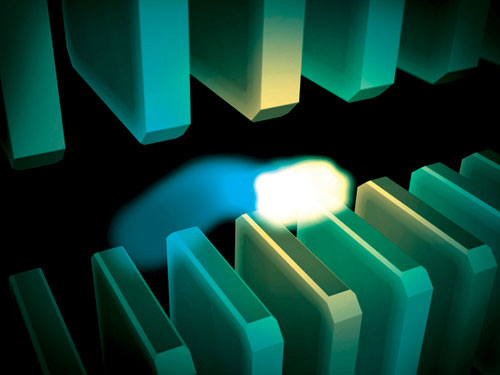 |
| In this artists conception, a pulse of electrons travels a wiggling path through an undulator, an array of magnets, in the LCLS. This causes the electrons to give off intense X-ray light shown here as a white glowwhich can be used to study structures as small as atoms and molecules. Image: SLAC InfoMedia |
Particle physics has done far more than deepen our understanding of the fundamental make-up of matter; it has forced researchers to invent the very tools with which to conduct their work.
First came the cyclotron, a circular accelerator for smashing subatomic particles together. The cyclotron spawned generations of ever-bigger accelerators, from one that would fit in your hand to the Large Hadron Collider, soon to open on the Swiss-French border, which spans several postal codes and requires teams of thousands to operate.
As it evolved, accelerator technology unexpectedly gave rise to a whole new field called photon science. It sprang from a major hassle confronting high-energy physiciststhe fact that electrons racing around in circles give off radiation in the form of X-ray light. Researchers found a way to put this “synchrotron radiation” to work; the result was a billion-fold increase in the brightness of X-rays available for probing processes at very small scales, and a new generation of machines known as light sources.
“Light-source science was born from the table scraps and headaches of physics research,” says Claudio Pellegrini, a physicist at the University of California, Los Angeles. “This is a case of using negative or unwanted phenomena, in which nature is helping us do what we want.”
Photon science is one of the most revolutionary spin-offs of high-energy physics, with practical impacts in fields ranging from medicine and archaeology to materials and environmental science.
Now, thanks to further advances in accelerator technology, photon science is poised to take another major leap at the Linac Coherent Light Source, or LCLS, scheduled to open next year at the Stanford Linear Accelerator Center. The LCLS will produce X-ray beams that are a billion times brighter still, paving the way for an entirely new way of understanding the chemistry of life and the physics of condensed matter.
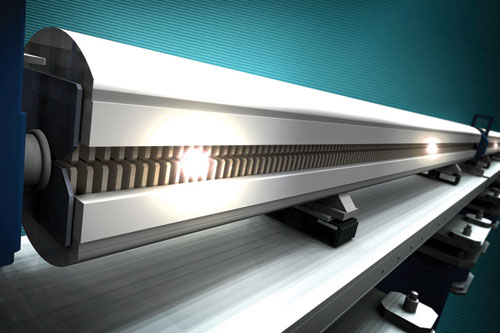 |
| One of the undulators within the LCLS. Each one weighs a ton and is about two meters long. The teeth in this rendering are actually alternating pairs of north-south magnetic poles. As pulses of electrons wiggle their way through the magnet array, they generate bright X-ray light. Image: SLAC InfoMedia |
For the first time, scientists could make 3D images of individual molecules, as well as 3D movies of chemical reactions and other dynamic processes never before seen by human eyes. Todays light sources can determine the structures of proteins; the LCLS will film them as they fold and unfold and interact with other molecules.
Research there could reveal the way substances really behave, taking us from computer models to real life, says David Tiede, who studies molecular motion at Argonne National Laboratory; hes among those hoping to use the new machine. “It will change the way we think about molecules,” he says. “This is really the start of a whole new science.”
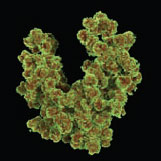 |
| Simulated image of a molecule as it might be seen by the LCLS, in 3D and with details as small as individual atoms. Researchers are especially eager to aim the LCLS beam at proteins, workhorse molecules that carry out most of lifes crucial functions. Image: SLAC InfoMedia |
Brighter, tighter, faster
Light source research facilities generate all kinds of light, from visible through ultraviolet and X-rays. Its the wavelength of that light that determines how small a structure we are able to see. The wavelength of visible light is slightly smaller than cells and bacteria, which is why we can see them under a light microscope. Hard X-rays have the very short wavelengths needed to illuminate even smaller objects, from viruses to proteins and other molecules. The LCLS will be the first machine of its type to probe matter with hard X-rays.
Whats more, it aims to generate beams a billion times brighter than those at todays synchrotronswhich are, in turn, about a billion times brighter than previous laboratory sources.
Synchrotrons made that initial leap by packing a billion times more photons, or light particles, into a single pulse. This decreased the exposure time needed to look at a sample from days to minutes, giving scientists the first practical way to study very small objects.
The LCLS will achieve another billion-fold increase in brightness by compressing photons into much shorter pulses, about one-quadrillionth of a second long. Like a high-speed strobe flash, these ultra-short pulses would freeze the motions of processes that happen very fastfrom electrons jumping from one energy level to another within an atom to chemicals reacting. The LCLS will reveal the first glimpses of the chemistry of life unfolding.
“The LCLS is as big a jump in peak brightness above storage rings as storage rings were above laboratory X-ray machines,” says John Galayda, director of construction for the project.
One downside to that kind of power is that it can blow a sample to bits. But because the LCLSs pulses are so fast, an image can be collected in the fraction of an instant before the sample blows apart.
The LCLS “will be a world-leading machine. Its an exciting machine. It will be a hard machine to make work,” says William Barletta, director of the US Particle Accelerator School, who is based at the Massachusetts Institute of Technology. “I dont think the people building it have any illusions that it will be easy. But SLAC has a long history of being able to tackle those kinds of technical challenges successfully.”
The first of its kind
Light from the LCLS will also be coherent, or laser-like, with its waves lined up like the tracks of snow skiers carving downhill in unison. Coherent beams give scientists the power to do a whole different class of experiments, including making 3D images of very tiny things.
The LCLS is a free-electron laser, or FELthe most powerful one in the world for some time to come. Free-electron lasers were developed in the 1970s by John Madey at Stanford University. Unlike traditional optical lasers, which generate light from excited atoms, FELs exploit unbound or “free” electrons moving through a vacuum chamber at nearly the speed of light to create their beams.
The key to achieving these coherent beams is an undulatora set of magnetsthat forces the electrons to wiggle back and forth. This causes them to give off X-rays, which in turn act back on the electrons, gradually nudging them into tighter and tighter bunches. The result is an electron “crystal”sheets of electrons, precisely layered, that produce intense, coherent laser radiation. If the magnet array is long enough, the electron pulse can achieve this state during a single pass. This feature is what permits an FEL to work in the hard X-ray region of the spectrum, according to Pellegrini, one of the developers of the theory behind the single-pass FEL.
To build the LCLS, crews are modifying SLACs two-mile-long linear accelerator, adding half a mile of tunnels chewed into the California sandstone.
With the recent end of data collection at the SLAC B-factory, the labs only on-site particle physics experiment, the LCLS also marks a shift in SLACs scientific emphasis from high-energy physics to photon science.
Five institutionsUCLA and Argonne, Brookhaven, Lawrence Berkeley and Lawrence Livermore national laboratoriesare collaborating with SLAC to build the LCLS, which is scheduled to start operations in 2009, at a total project cost of $420 million.
Though the LCLS will be the first of its kind, a number of similar machines are soon to follow. Japan is scheduled to open the SCSS, or SPring-8 Compact SASE Source, in 2012, and Hamburgs DESY lab plans to open the European XFEL in 2013. Like the LCLS, both will generate short-wavelength X-rays. How short? A hydrogen atom is about one ångstrom, or one ten-billionth of a meter, in diameter; the typical distance between atoms in a molecule is also one ångstrom. LCLS will generate X-rays as short as 1.5 ångstroms; the European XFEL, down to 0.8 ångstrom; and SCSS, one ångstrom.
“Theres a big class of experiments thats just waiting for FELs to be available,” Barletta says. There are many, many more potential users than there will be beam time to go around.
Future possible upgrades to the LCLS include installing additional undulators to create softer or harder X-rays. The machine now uses just one-third of the two-mile-long linear accelerator to rev up electrons; eventually it could use the entire linac to drive multiple experiments at various wavelengths.
Turning trash into treasure
Even though the LCLS became a technical possibility only within the last 15 years, it has a long pedigree that begins with the birth of high-energy physics.
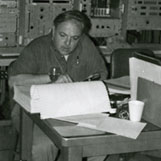 |
| SLACs Burton Richter analyzing data from the SPEAR storage ring, which opened in 1972. He shared the 1976 Nobel Prize in Physics for the discovery of J/Ψ particle there. Photo: Vera Luth, SLAC |
The early decades of accelerator research centered on firing beams of particles at fixed targets to probe the inner workings of atoms. But in the 1970s, a group of physicists at SLAC, led by Burton Richter, proposed a project to store accelerated particles in a ring-shaped vacuum chamber lined with magnets. Within this ring, opposing beams of positrons and electrons could circulate for hours at a time, colliding many times a second; in the debris, scientists looked for clues about the behavior and identity of subatomic particles, deepening our understanding of the fundamental laws of physics.
However, researchers paid a price for the efficiency of storage rings. Electrons, positrons, and other charged particles dislike being forced to travel in a circle, and they express their displeasure by radiating waves of electromagnetic energy. That energy was a downright nuisance for early particle physicists, who had to shield themselves and their sensitive equipment from this synchrotron radiation.
As colliding-beam storage rings became increasingly powerful, the synchrotron radiation became more intense, to the point where X-ray physicists began to take notice. When operated at energies of a few billion electron volts, or GeV, colliding-beam rings produced synchrotron radiation in the form of very bright hard X-rays.
Richter went on to share the 1976 Nobel Prize in physics for the discovery of the J/Ψ particle with SLACs colliding-beam storage ring, and later became director of SLAC. From the earliest days, he and a handful of other researchers had agreed that perhaps those X-rays could be put to good use.
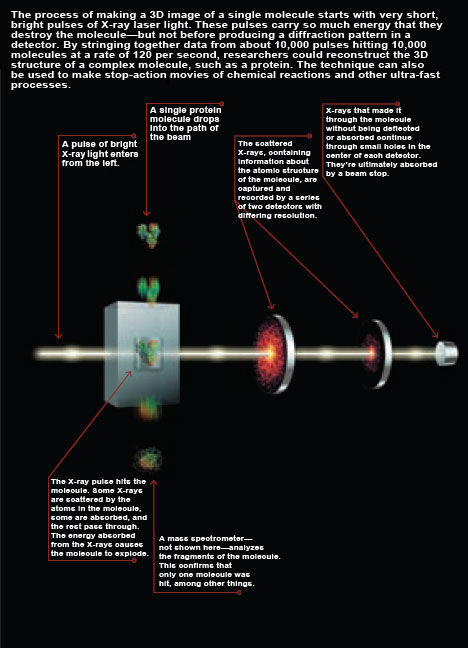 |
| Image: SLAC InfoMedia. Text: Glennda Chui and John Arthur, SLAC. |
“Sebastian Doniach and William Spicer came to me and said that if we could let the X-rays out, they could revolutionize condensed matter physics,” says Richter. The two men, he says, delivered on that promise.
Thirty years later, more than 60 light sources around the world generate intense beams of synchrotron light, mostly in the form of X-rays and ultraviolet light.
Almost all branches of science have benefited from “letting the X-rays out.” Synchrotron users are developing better ways to capture solar energy and store and use hydrogen as an energy supply. Projects are under way to map the structures of all the proteins in our bodies. And environmental scientists use synchrotrons to understand how pollutants move through the environment, resulting in better methods for cleaning up toxic waste.
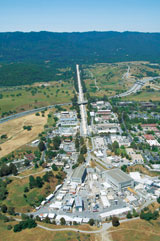 |
| Photo: SLAC |
Straightening the circle
As photon science continued to mature, high-energy physics reached a roadblock in the effort to push electron accelerators to higher energies. The circular design had reached its limit of practicality; studying physics phenomena with electron beams at energies greater than a couple of hundred GeV would require an entirely new kind of machine.
Enter the linear collider, a machine conceptualized around the straight design of the original fixed-target accelerators. Because it has no curves, it generates a minimum of unwanted synchrotron radiation. And in principle it could achieve much higher energies than a circular collider of the same length.
The Stanford Linear Collider, or SLC, operated from 1989 to 1998 and was the first test bed for the linear collider concept. Because it was the first of its kind, and because the technical requirements for producing collisions at the interaction point were so stringent, getting the SLC to work tested the abilities and patience of physicists.
“The initial problem was reliability,” says Nan Phinney of SLAC, the accelerator systems project leader for the SLC. “If a machines not very well understood, and it breaks and you put it back together again, it takes a long time to recover. If it breaks enough, you might never recover.”
It took five years to bring the SLC to the point where it could start collecting data. But once it got there, it turned in a stellar performance, collecting precise measurements associated with the Z boson and helping to further elucidate the link between the electromagnetic and weak forces.
The expertise gained at the SLC gave photon scientists a new range of possibilities to consider. Once again, they put those lessons to use in creating the next-generation light sourcethe LCLS.
“No one would have proposed the LCLS if the SLC hadnt happened,” says Phinney. “It would have been unthinkable.”
Transforming research
Liberating those first hard X-rays from electron accelerators transformed how we study just about everything in science. For instance, by pinpointing the locations of tiny traces of metal in slices of brain tissue, scientists are gaining a better understanding of the mechanisms of diseases such as Parkinsons and Alzheimers. At the Rocky Flats weapons plant in Colorado, synchrotron studies saved taxpayers billions in cleanup costs by showing how uranium binds with soil, giving specialists the key to efficiently halting its movement. Synchrotrons also played a role in discovering the structure of RNA transcriptase, a molecule responsible for telling our cells which proteins to make. That work garnered Stanford professor Roger Kornberg a Nobel Prize in Chemistry in 2006.
The study of proteins, in fact, may be the field most influenced by synchrotron science. Proteins are the workhorse molecules that carry out most of the functions in our bodies, and their structures give clues to how living things work at the most fundamental levels. To work out a proteins structure, researchers first grow a purified sample into a crystal, usually no bigger than a grain of salt, and expose it to a needle-thin beam of X-rays, which diffract and interfere with each other and register a distinctive pattern on a detector. Researchers use that pattern to work out the structures of individual molecules.
Synchrotrons have made it possible to conduct such studies in volume, creating a growing library of protein structures that are invaluable for research in biology and medicine. However, some proteins refuse to be crystallized, leaving no way to study their structures in detail.
The LCLS removes this obstacle; it can make 3D images and movies of samples that have not been crystallized. This will allow scientists to study processes they cant reach in any other way. They might create and probe new states of matter, including ultra-high-temperature plasmas like those at the center of the sun. Researchers could also selectively remove electrons from an atomup to an entire orbital shell at onceto create “hollow atoms” that tell us about the behavior of matter that doesnt exist in nature.
“The first science from the LCLS will be very exciting, says SLAC Director Persis Drell. But the LCLS is such a revolutionary tool that I believe the greatest experiments that will be done are the ones we havent even thought up yet.”
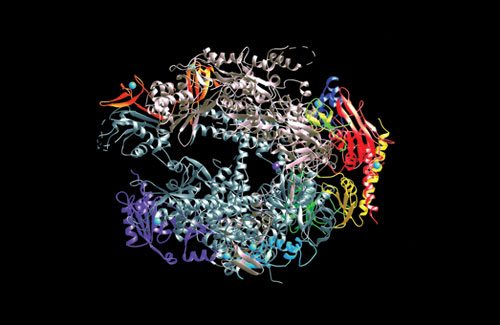 |
| This protein molecule, called RNA polymerase, contains more than 30,000 individual atoms. It plays a vital role in copying the genetic information contained in DNA and translating it into the chemical processes that are the foundation for life. Scientists worked out its structure using diffracted beams of X-rays generated by a synchrotron. Image: SLAC |
Click here to download the pdf version of this article.






